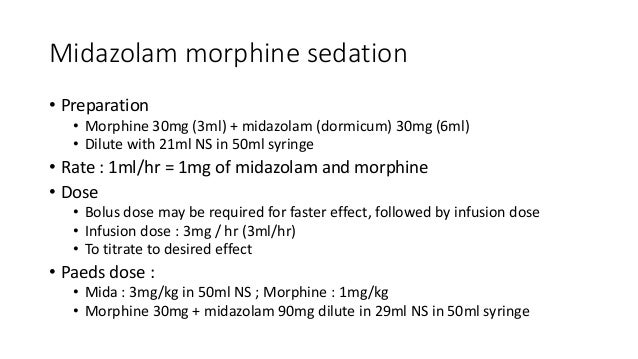| Uploader: | Zulkigul |
| Date Added: | 27 February 2013 |
| File Size: | 57.2 Mb |
| Operating Systems: | Windows NT/2000/XP/2003/2003/7/8/10 MacOS 10/X |
| Downloads: | 11463 |
| Price: | Free* [*Free Regsitration Required] |
Pain due to nerve compression may be reduced by a corticosteroid such as dexamethasonewhich reduces oedema around the tumour, thus reducing compression.
Midazolam Subcutaneous infusion solution should be monitored regularly both syribge check for precipitation and discolouration and to ensure mirphine the infusion is running at the correct rate.
Octreotidewhich stimulates water and electrolyte absorption and inhibits water secretion in the small bowel, can be used by subcutaneous infusion to reduce intestinal secretions and to reduce vomiting due to bowel obstruction. Prescribers should ensure that they are familiar with the correct use of transdermal preparations, see under buprenorphine and fentanyl inappropriate use has caused fatalities.
Intractable cough Intractable cough may be relieved syringd moist inhalations or by regular administration of oral morphine.
When and how to use a syringe driver in palliative care
An antiemetic is usually necessary only for the first 4 or 5 days and therefore combined preparations containing an opioid with an antiemetic are not recommended because they lead to unnecessary antiemetic therapy and jorphine side-effects when used long-term. In particular, chlorpromazine hydrochlorideprochlorperazineand diazepam are contra-indicated as they cause skin reactions at the injection site; to a lesser extent cyclizine and levomepromazine also sometimes cause local irritation.
Initiation of an opioid analgesic should not be delayed by concern over a theoretical likelihood of psychological dependence addiction.
It is kinder to give an intermittent bolus injection subcutaneously —absorption is smoother so that the risk of adverse effects at peak absorption is avoided an even better method is to use a sydinge butterfly needle.
Nausea and vomiting may occur with opioid therapy particularly in the initial stages but can be prevented by giving an antiemetic such as haloperidol or metoclopramide hydrochloride. Anorexia Anorexia may be helped by prednisolone or dexamethasone.

Subcutaneous infusion solution should be monitored regularly both to check for precipitation and discolouration and to ensure that the infusion is running at the correct rate. The ability to gain effective symptom control due to steady plasma drug concentrations without peaks and troughs Allows management of multiple symptoms through the use of combinations of medicines given via a single route The single route of administration minimises the need for repeated injections or multiple oral medicines Subcutaneous administration of medicines is more comfortable for the patient than intramuscular injections particularly if the patient is cachexic and is simpler and less invasive than medicines given intravenously The ability for patients who are still mobile to remain so, and once set up enables more independence.
The child's hands, feet and face may be cold, pale and cyanotic. The first syringe of a new prescription will lose some of the solution when the line is primed, therefore the infusion will not run for a full 24 hours.
Prescribing in palliative care | Medicines guidance | BNF content published by NICE
Doses of medication should be recorded for parents on a treatment sheet and drugs already drawn up in the syrunge. Confusion and restlessness Haloperidol has little sedative effect.
Guidelines for syringe driver management in palliative care in New Zealand. Incontinence There may be a relaxation of the muscles of the gastrointestinal and urinary tracts resulting in incontinence of stool and urine.
Terminal Care
Cyclizine is particularly likely to precipitate if mixed with diamorphine or other drugs see under Mixing and Compatibility, below Metoclopramide hydrochloride can cause skin reactions. Speech may become increasingly difficult to understand and words confused. Without a home care pack moprhine may be a considerable delay in getting drugs required for symptom relief.
Parents may wish to change their child's clothes and keep them warm with a blanket or doona. For the dose by subcutaneous infusion see below.
For the treatment of nausea and vomiting associated with cancer chemotherapy see Cytotoxic drugs. Repeated administration of intramuscular injections can be difficult in a cachectic patient. If this fails, metoclopramide hydrochloride by mouth or by subcutaneous or intramuscular injection can midaazolam added; if this also fails, baclofenor nifedipineor chlorpromazine hydrochloride can be tried.
Benzodiazepines, such as temazepammay be useful. The goals of administering medicines via a syringe driver therefore need to be discussed with the patient and family and any concerns addressed. Nerve blocks or regional anaesthesia techniques including the use of epidural and intrathecal catheters can be considered when pain is localised to a specific area.

Review pain management if rescue analgesic is required frequently twice daily or more. Parents who are not prepared will be distressed when this occurs. If possible, doses should be given through midxzolam side port in the syringe driver cannula line to minimise patient distress.
Problems encountered with syringe drivers The following are problems that may be encountered with syringe drivers and the action that should be taken: Convulsions If a patient has previously been receiving an antiepileptic drug or has a primary or secondary cerebral tumour or is at risk of convulsion e.

Dexamethasonespecial care is needed to avoid precipitation of dexamethasone when preparing it. Monitoring the infusion Patients being cared for at home should ideally have a daily visit from a health professional for review of symptom control and monitoring of the infusion.

No comments:
Post a Comment